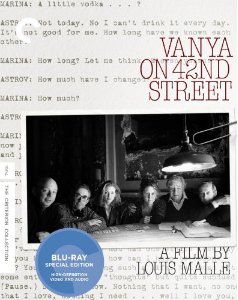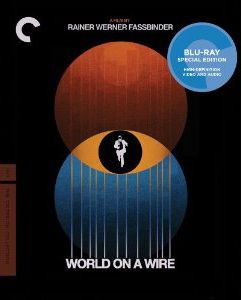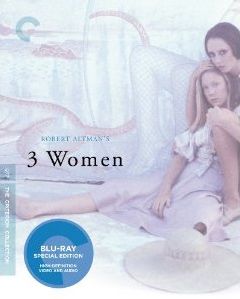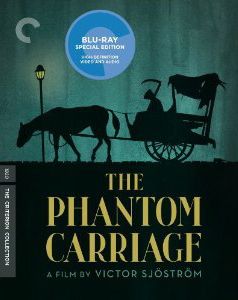Meeting The Criterion: VANYA ON 42ND STREET, WORLD ON A WIRE, 3 WOMEN, THE PHANTOM CARRIAGE.

The process of self-education continues. This month a theme emerged connecting all the films for me. Characters trapped, by the past, the future, the need for identity and finally by death itself peopled the stories told by the likes of Robert Altman, Louis Malle, Rainer Werner Fassbinder and the man who inspired the great Ingmar Bergman to become a filmmaker, Victor Sjostrom. The stories themselves ranged from ghostly fantasy, to psychological horror, existential drama and science fiction but that connecting thematic thread, being trapped, offered a rich and diverse, even holistic exploration of mankind's desire to slip the surly bonds of current physicality, politic and existential angst into a transcendent self. This was a heady, exuberant trip outside cultural comfort zones and a constant reminder of the deep and abiding control these men exhibited over cinematic technique.
VANYA ON 42ND STREET BluRay

Made in 1994, this film adaptation of the play Uncle Vanya by Anton Chekov is a wonder of subtlety and craft based on the English translation by David Mamet, it offers a bold staging of the story and marvelous performances by its cast. But the most extraordinary
thing about Vanya on 42nd Street is the back story of how it came to be a film. The actual creation of the piece, which was workshopped as a play over a period of four years is covered in a stunning half hour documentary special feature titled, Like Life: The Making of Vanya on 42nd Street, which reveals not only the history but much of the philosophy and individual emotional journeys that kept participants so committed to the project. Everyone involved speaks of being deeply challenged, moved, infuriated, stripped down by the work and by play director Andre Gregory, who rigorously kept commercial concerns at bey as the group met and finally began to showcase their work. The piece was never performed for more than 25 especially invited friends and acquaintances at a time, rehearsal and performances took place in abandoned theaters and nobody got involved in the project with the thought of making a dime.
By the time Louis Malle was approached to turn the project into a film it was almost an afterthought, a way for everyone to say goodbye. The irony was that the cast was so used to trying anything in their efforts to mine the material that every single performance was different, sometimes wildly so. Coming to grips with the need to produce something Malle would be able to take into the editing room took some effort. The whole struggle is covered in this glorious companion doc and is worth the price of the disc all by itself.
We pick up the actors, (and the actual director of the play, Andre Gregory) on the street as they make their individual journeys toward the theater. On arriving reality blurs into fiction. Told with no costuming or substantial props, and set in the real-life abandoned New Amsterdam Theater on 42nd Street in New York City this version of Vanya moves from life to stage and back again with no warning but much power. The play tells the story of a family split apart by the frustrated hopes, and complicated relationships, that undermine their search for individual happiness. An elderly professor (George Gaynes), and Elena (Julianne Moore), his beautiful young second wife arrive for a visit at the rural family estate which has financially supported them in their city lifestyle. Vanya (Wallace Shawn), the brother of the professors first wife, can barely hide his bitterness at the scholar even as he desperately longs to start an affair with Elena. The professor's plain young daughter Sonya (Brooke Smith), from his first marriage deeply yearns for the local doctor (Larry Pine), an alcoholic who has become infatuated with Elena. Things come to a head when the professor announces his intention of selling the estate to provide a better life for himself and his new wife.
Almost everyone seems sympathetic here on some level. It's the genius of Chekov to take his loose theme of the sense of a wasted life and make his audience identify with his characters longing for love and identity, even as they short-change and short-circuit each other and their own success. If Vanya is, more than ever, a story for our times, then this is why. The play doesn't blink, it's characters are desperate about the right things even if they are clueless about how to get them.
Wallace Shawn who plays the titular Vanya had previously worked with Malle and Gregory on My Dinner With Andre (1981). Better known as the character of Vizzini in The Princess Bride (1987), Shawn is expertly cast here, bringing a brave desperation to Vanya who ultimately crumbles under the weight of his own unrealistic expectations of life.
Hugely impressive as well is Brooke Smith as Sonya. Smith first came to prominence in the role of Catherine Martin, the abducted daughter of Sen. Ruth Martin in Silence of the Lambs (1991). Since then she's gone on to appear in a wide variety of TV and film roles including long stints on Crossing Jordan and Grey's Anatomy. She's pivotal here in the way she embraces Sonya's childlike insecurity and resentment while still managing to provoke sympathy as the object of unrequited love. Larry Pine, Julianne Moore, and George Gaynes....hell just list everyone in this cast. There are no weak links only devastating portrayals of sad, lost lonely people who can find no comfort in one another.
The only other extra is a booklet containing excellent essays by writer Steve Vineberg and an onset report by film report Amy Taubin. Both of these are great. This is a stellar looking, great sounding BluRay of an all too obscure film that deserves a place in the collection of any cineaste.
WORLD ON A WIRE aka Welt am Draht BluRay

Show of hands please. Heard of Rainer Werner Fassbinder? Okay hands down. Of those who have heard of him who has heard of much less seen this? Sadly it's not at all odd that such an important work by such a respected filmmaker would would take decades to get the attention it deserves. Made in 1973 as a two-part mini-series for German TV, World On A Wire was broadcast twice and quickly forgotten about until unearthed for a Fassbinder retrospective decades later. Since then a brief revival tour and this excellent BluRay release have raised some awareness of how ground breaking a project it was. Tron (1982), Bladerunner (1982) and The Matrix (1999) and the countless other films and TV shows using virtual reality as their major theme were all preceded by World on A Wire and the novel upon which it is based, Silmulcron 3 by Daniel F. Galouye (1964) The proceeding decades may have robbed the this seminal work of some of its novelty but the raw power of it's philosophical quandrys, "How are we to know what is real?" and "Does it even matter if we know?" seem even more resonant today than ever.
In an indeterminate future time a leading business concern has invented a computer project called Simulcron. The project allows for the creation of totally synthetic virtual beings and worlds allowing observers to, among other things, predict trends in manufacturing and economics. After a series of ethically questionable meetings with industrialists concerns, project leader Henry Vollmer dies in mysterious circumstances and his successor Dr. Fred Stiller begins to experience painful fugues and what may or may not be hallucinations. People disappear in the middle of conversations, others claim these people never existed at all. Determined to get to the bottom of the mystery Vollmer soon finds himself pursued, unable to trust associates, friends or even lovers. But a startling revelation proves even more troubling. He may not be able to trust himself. He may only be a computer projection. Which world is real and which is merely a world on a wire?
Despite the dystopian angle the end product is far more than just a luddite anti-tech fantasy or some weird inversion of Freud's theory of the uncanny.The novel and the film adaptation are just as concerned with the human equation, the existential burning need to know the truth about origins and existence, as they are with questions of technology. Nor is World on A Wire best understood as merely a continuation of Fassbinder's unending fascination with the conspiratorial. Here the conspiracy is wrapped in riddles than when unwrapped eventually lead, or at least point, to the transcendent. Yet there's hardly a cynical note sounded.
Other than that this is very much a Fassbinder film. World on A Wire is all about the gaze, point of view and reflections. Fassbinder constantly brings mirrors into play as well as a whole host of narrative devices that highlight power relations and the nature of human connection. Fassbinder's death by drug overdose at age 37 blew a wide hole in the New German Cinema as it was called. His contemporaries included Werner Herzog and Wim Wenders but while those directors eventually found a home in more traditional modes of narrative Fasbinder and his work, has remained, like many of his characters, a bit off to the side, occasionally noticed rather than currently studied.
This BluRay packs a new digital transfer personally supervised by cinematographer Michael Ballhaus. The end result is excellent. Soundtrack is uncompressed monoaural. Extras include a fifty minute documentary that explores the making of the film, an interview with scholar Gerd Germunden that places the film in the context of Fassbinders uouvre, and an excellent essay exploring the themes and driving ideas of the material by film critic Ed Halter.
3 WOMEN BluRay

Is Robert Altman a cult figure? By cult I mean an important figure in the history of cult film. To be sure he made his share of odd little films that seem to fall in that category. If your only experience of his work is stuff like Popeye (1980), which I love, or Gosford Park (2001), you owe it to yourself to track down the little talked about sci-fi thriller Countdown (1967), the counter-culture comedy classic Brewster McCloud (1970) or the horror film Images (1972). But for 3 Women (1977), genre labels need not apply. The film trumps all of the above for pure surreality, existing on its own plane, a dreamlike yet deeply unsettling masterpiece of displacement caught up in questions that it chooses to highlight rather than answer. Prepare to float through this, heretofore neglected, visually beautiful and thought provoking piece of Altman cinema
Pinky (Cissy Spacek) is a gawky and seemingly naive young adult who gets a job in a penny-pinching desert Spa. When management assigns Millie (Shelley Duvall), a self absorbed faux fashionista, to show her the ropes it comes out that Pinky, new in town, has nowhere to stay. Soon the two are sharing Millie's apartment and thick as thieves. 3 Women, wastes no time in creating the weird tension that gives it so much power. Pinky seems to be an innocent abroad and while Millie is eager to show her how to live the life of the housekeeping and fashion magazines she so loves, it becomes apparent that Pinky knows more than she's let on. The more Millie talks the more apparent it becomes that she herself is not what she wishes to be.
Other characters too are draped in a sort of mystery. The very pregnant woman who manages the apartment complex paints grotesque nude images on the pool patio floor that seem to simultaneously suggest an ambiguous violence driven by war between genders. But these startling neo-aquatic creatures could easily be abstract representations of the various senior citizens that populate the spa's own hydro therapy and pool exercise areas. Either way, what is driving, the almost obsessive need, she has to paint them? Her husband, and the only male of any consequence, and the apartment complex owner is gender throwback defining him self through his hard drinking, and constant flirting.
The movie has many more delicious oddities to unveil and taken together they suggest something that could be interpreted as fantasy like or malevolent. Guns and Good Housekeeping figure into an increasingly dark plot that has characters trading places, appearing and disappearing and finally absorbed into one another. 3 Women is almost impossible to watch casually. What it does reward however is a willingness to enter into the dream logic that inspired Altman when he got the film greenlit by 20th Century Fox without a script in hand.
The BluRay offers typically great Criterion sight and sound. Extras include an commentary by Altman in which he discusses not only every aspect of the preproduction and making of the film but his approach to filmmaking in general. Altman is one of those filmmakers you wish you could just sit at the bar with as he says one insightful little thing after another. He was absolutely fearless in trying new things right up to the time he passed away. It can truly be said of almost all his lesser films that they are important films, films that should be watched by those who want to apprehend the mind of a true artist at work. 3 Women is NOT one of those lesser films and with any luck it will now not be the least known.
THE PHANTOM CARRIAGE BluRay

Like many cineastes my introduction to silent film started with shorts. Chaplin, the Keystone Cops etc. Then came features like Nosferatu (1922), Vampyr (1932), The Phantom of the Opera 1925) and The Hunchback of Notre Dame (1923) which I sought out because they were horror films. Metropolis (1927) too was recommended by the vaunted pages of Famous Monsters of Filmland magazine. Lastly I remember watching Battleship Potemkin (1925) in a high school history class, though it had no particular effect on me at the time. In short silent films were marked by my young mind as the stuff of melodrama, overacting, and clunky outdated camera technique a general broadness that seemed to lack subtly. Stuff, that was as far as I was concerned made silent cinema a mere technical curiosity, a mode that cinema had thankfully outgrown.
Then a few years ago I saw The Passion of Joan of Arc (1928) and my world exploded. Here was a film that could have been made yesterday. Yes it was big, full of closeups of people in extreme emotional states. Yes the narrative situation invited melodrama. But there no doubt that this was a film for today, that could speak to anyone who had ever felt wrongly accused, judged. It changed the way I looked at film, much less silent film.
The Phantom Carriage may well have done the same for me. It isn't as perfect a film as The Passion of Joan of Arc but it is an incredibly moving one. I'm not alone in that estimation. No less a cinematic luminary than Ingmar Bergman claimed to have seen the film more than 100 times in his youth and credited it with inspiring him to become a filmmaker.
Director Victor Sjostrom also plays the lead David Holstrom, a profligate ne'er-do-well whose hard drinking ways and callousness corrupt others and eventually lose him his family. Scornful of the Salvation Army worker who would help him change he repents when he sees the influence he has had on his brother only to return home to an empty house. The abandonment enrages him. He makes up his mind to become twice as evil as before even going so far as to cough in the faces of people in the hope that will become infected with his Tuberculosis.
Then one night surrounded by his derelict friends he tells the story of The Phantom Carriage which must be driven for one year by the unlucky soul who dies at midnight on New Years Eve. The driver must also pick up the newly departed. Holm finishes the story to find himself summoned by a reformed drinker to the death bed of his would be Salvation Army savior. Laughing off the request he finds his heartlessness offends even his most morally broken friends. A fight ensues and Holm is killed on the stroke of midnight New Years Eve.
Approached by the phantom coachman he is told he must take the reins but before then he will be given a tour of all the suffering he has caused including events which have yet to take place. To say more is unnecessary. The film clearly owes a debt to Dicken's A Christmas Carol but in reality is based on a novel by Nobel Prize winner Selma Lagerlof. The point is that the film is a masterpiece of emotional depth that also happens to feature special effects and techniques that were groundbreaking at the time it was made. The story is told largely in flashback, with many beautifully tinted sequences and expertly crafted double exposures used to bring the ghostly carriage, its driver and the victims to life.
Sjostrom is stunning as Holstrum expertly carrying the character through the widest possible emotional range. We feel everything intended. His snideness, his outrage and arrogance, and finally his deep regret and repentance. The BluRay looks absolutely amazing as the film was restored with the help of the Swedish Film Institute. Of the two scores I prefer the one by Matti Bye which seems less modernized although the experimental score by KTL certainly has it's charms. Casper Tybjerg offers a historical commentary that sheds much light on this neglected classic. The remaining extras on this excellent package include an excerpted interview with Bergman and still another Bergman addendum detailing the films influence on the master's future career by Bergman historian Peter Cowie. The booklet features an essay by screenwriter and filmmaker Paul Mayersberg.







